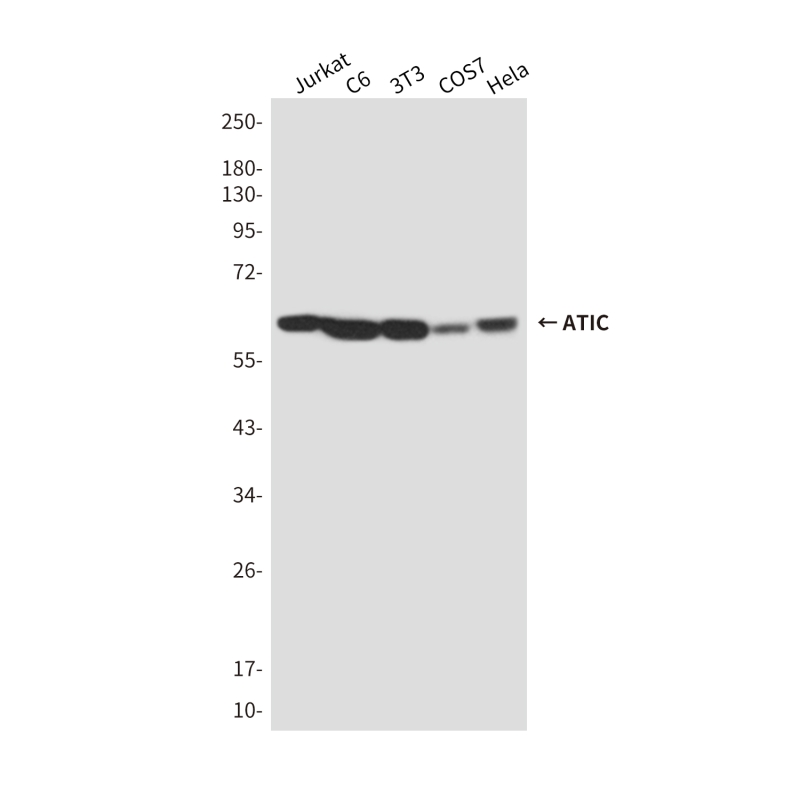
| WB | 咨询技术 | Human,Mouse,Monkey,Rat |
| IF | 咨询技术 | Human,Mouse,Monkey,Rat |
| IHC | 咨询技术 | Human,Mouse,Monkey,Rat |
| ICC | 技术咨询 | Human,Mouse,Monkey,Rat |
| FCM | 咨询技术 | Human,Mouse,Monkey,Rat |
| Elisa | 咨询技术 | Human,Mouse,Monkey,Rat |
| Aliases | PURH; AICAR; AICARFT; IMPCHASE |
| Entrez GeneID | 471 |
| WB Predicted band size | Calculated MW: 65 kDa; Observed MW: 65 kDa |
| Host/Isotype | Mouse IgG1 |
| Antibody Type | Primary antibody |
| Storage | Store at 4°C short term. Aliquot and store at -20°C long term. Avoid freeze/thaw cycles. |
| Species Reactivity | Human,Mouse,Monkey,Rat |
| Immunogen | Purified recombinant human ATIC protein fragments expressed in E.coli. |
| Formulation | Purified antibody in PBS with 0.05% sodium azide,0.5%BSA and 50% glycerol. |
+ +
以下是3篇与ATIC抗体相关的研究文献概览,涵盖不同研究方向:
---
1. **标题**: *"Autoantibody against ATIC protein in patients with dermatomyositis"*
**作者**: Sato S, et al.
**摘要**: 该研究发现抗ATIC抗体可作为皮肌炎(尤其是合并间质性肺病患者)的新型血清标志物。研究通过免疫沉淀和质谱分析鉴定了该抗体,并证实其与疾病活动性相关。
---
2. **标题**: *"Structural basis of human ATIC subunit assembly mediated by conserved antibody recognition"*
**作者**: Li Y, et al.
**摘要**: 研究利用特异性抗体制备人源ATIC蛋白复合体,通过X射线晶体学解析其三维结构,揭示了二聚化界面关键区域,为靶向嘌呤合成的药物设计提供了结构基础。
---
3. **标题**: *"ATIC overexpression promotes colorectal cancer metastasis through epithelial-mesenchymal transition"*
**作者**: Wang H, et al.
**摘要**: 通过免疫组化(使用抗ATIC单克隆抗体)发现结直肠癌中ATIC蛋白高表达与EMT标志物(如E-cadherin下调)显著相关,机制研究表明ATIC通过激活AKT/GSK3β通路促进肿瘤转移。
---
**补充说明**:
- 上述研究展示了ATIC抗体在自身免疫病诊断(文献1)、结构生物学(文献2)及癌症机制研究(文献3)中的典型应用。
- 实际引用时建议通过PubMed或期刊官网核对原文信息。若需最新文献(2023年后),可进一步检索预印本平台(如bioRxiv)。
ATIC (5-Aminoimidazole-4-carboxamide Ribonucleotide Formyltransferase/IMP Cyclohydrolase) is a bifunctional enzyme encoded by the *ATIC* gene, playing a critical role in the *de novo* purine biosynthesis pathway. It catalyzes the final two steps of purine synthesis: the conversion of 5-aminoimidazole-4-carboxamide ribonucleotide (AICAR) to formyl-AICAR and the subsequent cyclization to inosine monophosphate (IMP). This pathway is essential for cellular proliferation, making ATIC a potential therapeutic target in rapidly dividing cells, such as cancers.
Antibodies targeting ATIC are widely used in research to study its expression, localization, and function in various biological contexts. They enable detection of ATIC protein levels via techniques like Western blotting, immunohistochemistry, and immunofluorescence. Dysregulation of ATIC has been implicated in metabolic disorders, autoimmune diseases, and cancer progression. For instance, elevated ATIC expression correlates with poor prognosis in certain malignancies, likely due to increased purine demand supporting tumor growth. Additionally, ATIC inhibitors, like L-Alanosine, are explored for anticancer therapies, and ATIC antibodies aid in assessing drug efficacy and resistance mechanisms.
These tools also contribute to understanding ATIC's non-canonical roles, such as modulating inflammatory responses via AICAR accumulation, which influences AMPK signaling. Overall, ATIC antibodies are vital for elucidating both metabolic and disease-related pathways.
×